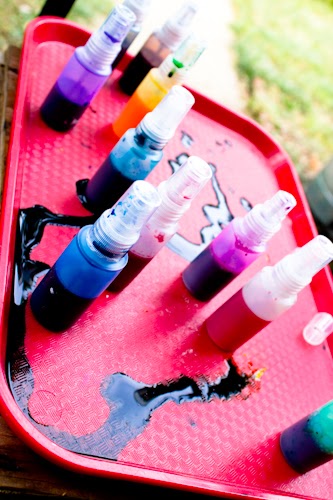Liquid watercolor paint spray watercolors tutorial craftknife knife craft painting bottle
Table of Contents
Table of Contents
Are you tired of using regular watercolors and want to try something new? Have you ever considered making your own watercolor spray paint? If so, then you’ve come to the right place! In this article, we’ll guide you through the process of making watercolor spray paint using only a few simple household materials.
The Pain Points of Making Watercolor Spray Paint
While making your own watercolor spray paint may seem daunting at first, it can actually be a fun and rewarding experience. Some common pain points that people experience when trying to make watercolor spray paint include not knowing which materials to use, not knowing how to mix the paint properly, and not being able to achieve the desired level of opacity or transparency.
How to Make Watercolor Spray Paint
To make watercolor spray paint, you will need the following materials: liquid watercolors, rubbing alcohol, a spray bottle, and white vinegar. Firstly, mix one part rubbing alcohol with one part water in the spray bottle. Next, add in a few drops of liquid watercolors and a small amount of white vinegar to achieve the desired level of opacity or transparency. Finally, shake the mixture well and your watercolor spray paint is ready to use!
Summary of the Main Points
In summary, to make watercolor spray paint, you will need liquid watercolors, rubbing alcohol, a spray bottle, and white vinegar. Mix one part rubbing alcohol with one part water in the spray bottle, add in a few drops of liquid watercolors and a small amount of white vinegar, and shake the mixture well. This will create your own watercolor spray paint that you can use for any project you like.
Creating Watercolor Spray Paint - My Personal Experience
Creating watercolor spray paint was something I had never tried before, but I was interested in learning how to do it. After doing some research and gathering the necessary materials, I gave it a try. The process was surprisingly easy and the results were amazing! I was able to create my own unique colors and adjust the level of opacity to my liking. It’s a fun and easy way to add some creativity to your art projects.
Troubleshooting Your Watercolor Spray Paint
If you’re having trouble achieving the desired level of opacity or transparency with your watercolor spray paint, try adding more or less rubbing alcohol or vinegar depending on what you’re looking for. You can also experiment with different types of liquid watercolors to achieve different colors and effects. Practice makes perfect, so keep trying until you find the perfect combination that works for you.
Going Deeper into the Explanation
When making watercolor spray paint, it’s important to remember that the amount of rubbing alcohol and white vinegar you use can greatly affect the final outcome. Rubbing alcohol helps to break down the liquid watercolors and create a more even spray pattern. The white vinegar acts as a binding agent and can help to create a more opaque or transparent finish depending on how much you use.
Experimenting with Different Materials
If you want to experiment with different materials, try using natural food coloring, powdered pigments, or even old eyeshadows to create unique colors. You can also add shimmer or glitter for a more sparkly effect. The possibilities are endless!
Question and Answer
Q:
Can I use regular watercolors instead of liquid watercolors?
A:
No, liquid watercolors are much more concentrated than regular watercolors and will give you a more vibrant and bold color. Regular watercolors may not mix well with the other ingredients and may clog your spray bottle.
Q:
Can I use a different type of alcohol instead of rubbing alcohol?
A:
While rubbing alcohol is the most commonly used alcohol when making watercolor spray paint, you can use other types such as vodka or isopropyl alcohol as a substitute.
Q:
Can I reuse old spray bottles?
A:
Yes, you can reuse old spray bottles as long as they are cleaned and washed thoroughly with soap and water beforehand.
Q:
Can I use this watercolor spray paint on different surfaces?
A:
Yes, this watercolor spray paint can be used on a variety of surfaces such as paper, canvas, or even fabric. However, it’s important to always test the paint on a small area first before applying it to a larger surface.
Conclusion
Overall, making your own watercolor spray paint is a quick and easy way to add some creativity to your art projects. With just a few simple household materials, you can create your own unique colors and achieve the desired level of opacity or transparency. Don’t be afraid to experiment with different materials and colors until you find the perfect combination that works for you. Happy painting!
Gallery
Craft Knife: Tutorial: Liquid Watercolor Spray Paint

Photo Credit by: bing.com / spray paint watercolor liquid tutorial knife craft combine conventional babies interesting let colors much than which use also so
32 DIY Paint Techniques And Recipes (With Images) | Liquid Watercolor

Photo Credit by: bing.com / paint make watercolor liquid own homemade diy painting easy making watercolors craft cheap diyjoy paints
Craft Knife: Tutorial: Liquid Watercolor Spray Paint

Photo Credit by: bing.com / liquid watercolor paint spray watercolors tutorial craftknife knife craft painting bottle
DIY Liquid Watercolor Paint | Stir The Wonder

Photo Credit by: bing.com / watercolor liquid diy paint water paints make kids tempera watercolors use easy crafts supplies affiliate contains links post colors
Watercolor Spray Paint

Photo Credit by: bing.com / spray paint liquid watercolor kids color decoration ganpati coloring bottles fun bottle painting water creative activities eyfs food paper simple





